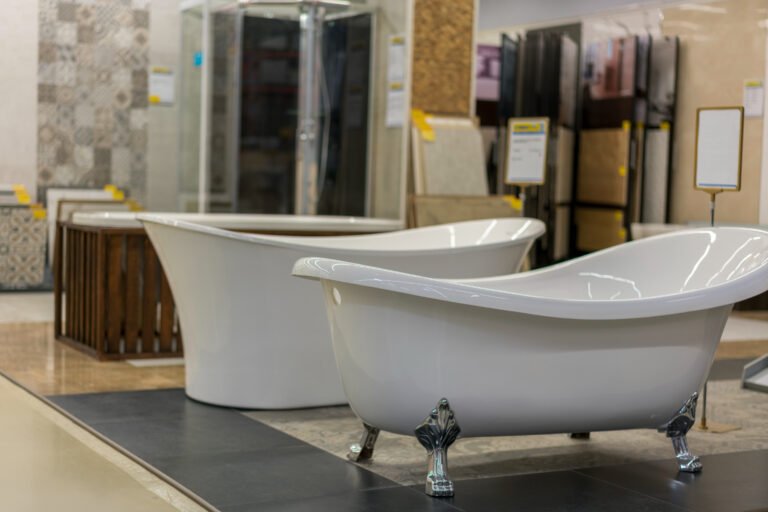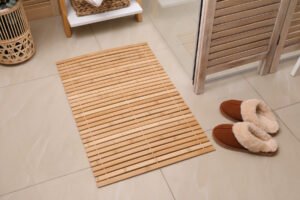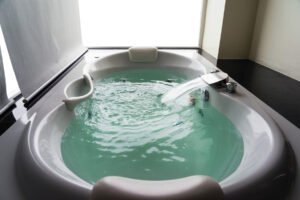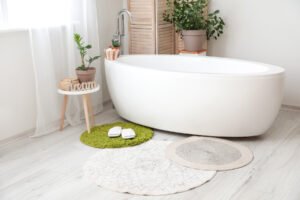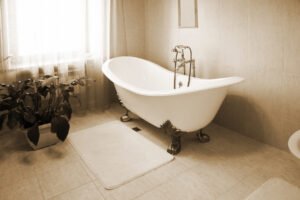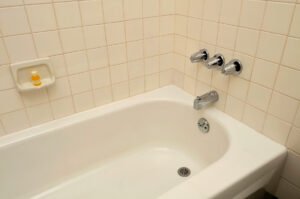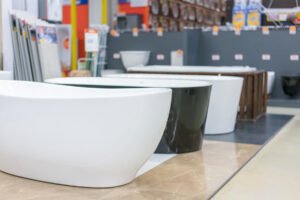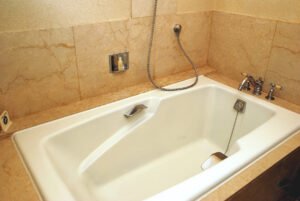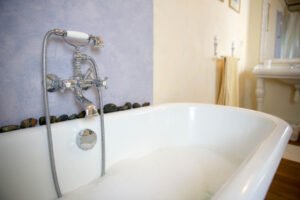Bathtubs are undoubtedly the key to good soaking and relaxing. But do you know that the wrong bathtub can do more harm than good? Improper bathtubs will disrupt your bathing experience and might not suit your bathroom walls and disturb your bathroom decor.
Fortunately, various bathtub styles and materials are available on the market, and all you need to do is do some research to find the best fit for your bathroom remodel.
And to make things easier, we surveyed the brochures and brought about the 27 best bathtub types based on the operations, installation, style, and materials for a prompt upgrade. So, let’s begin exploring!
Types of Bathtubs Based on Tub Operations
Bathtub operations are multi-fold and cover a vast arena, from soaking to jets and hot tubs, which enhance bathing and user comfort in their own way. So, let’s get familiar with the different tub operations, mechanisms, and user experiences to find the best one for you.
1. Standard Bathtub
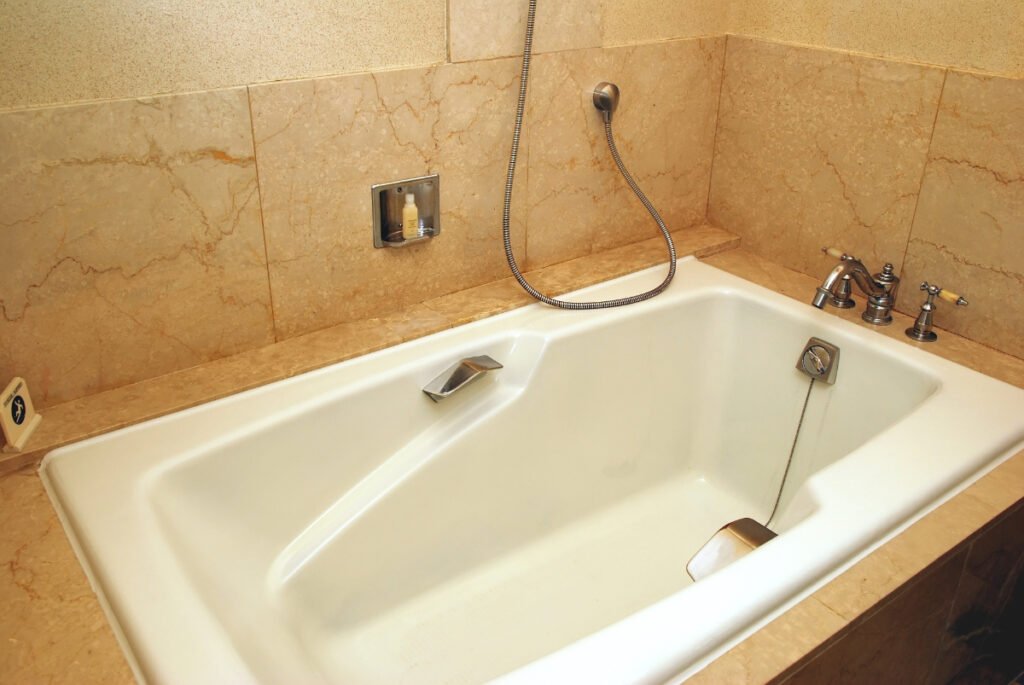
Where to use: Ideal for master or family bathrooms, guest baths, or apartments with long walls that can anchor the tub.
Standard bathtubs are usually 5 feet long, 30 inches wide, and 5-6 inches deep. They take up a lot of space in the bathroom but provide a basic bathing and soaking experience to larger families. Moreover, they are highly affordable at $500-1000 per piece but require regular cleaning to maintain their white surfaces.
Further, standard tubs withstand heavy drilling and can support one-holed or three-holed faucets and a heavier bridge tap or shower combo. You can check for more ideas on bathtub faucets here.
Prominent Materials: Porcelain enamel steel, cast iron, Acrylic, Fiberglass, and Cast Polymer.
Things to Note:
- Standard bathtubs damage and turn yellow with age. Hence, you‘ll need to bleach them to eliminate stains and enjoy shinier surfaces annually.
- These are comparatively larger and require a good-quality vent and p-trap for efficient drainage.
2. Soaking Bathtub
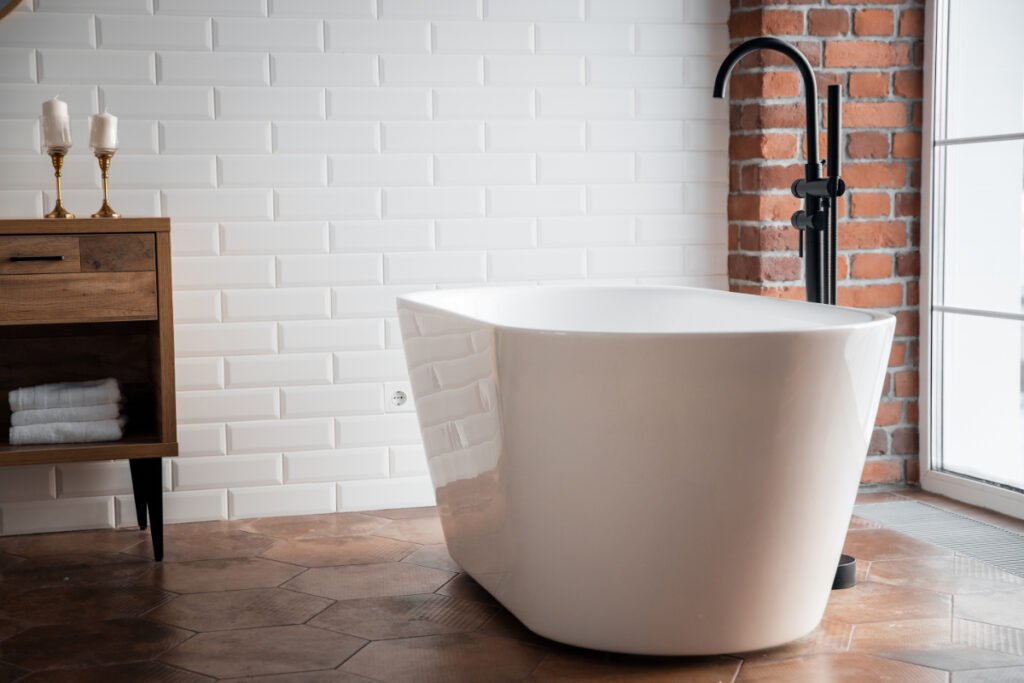
Where to use: Use them for relaxation, massage, or hydrotherapy in indoor and outdoor settings.
A soaking tub is 14-16 inches deep and holds more water than any other bathtub. Here, you can customize it according to your bathtub style and decor or pick traditional oval soaking tubs for a modern aesthetic and gliding comfort.
You can even use ergonomic and affordable slippers or boat soaking tubs for more stretching space and cozy seating angles.
Prominent Materials: Stone-Resin, Cast Iron, Porcelain, Marble, Wood, and Ceramic.
Things to Note:
- Soaking tubs are expensive and cost about $3000-5000, depending on the material.
- They are pretty heavy and might need additional reinforcements for support.
3. Whirlpool Bathtub
Where to use: Choose them for hydrotherapy or a spa-like experience in medium-sized bathrooms.
A whirlpool tub uses bubbles and water jets to circulate warm water and curate a relaxing, massage-like experience for users. Of course, it is expensive and smaller, but it maintains optimal water temperature and aids arthritis patients.
Plus, this tub does not require much maintenance as the circulatory water itself eliminates soap scum deposits and clogs.
Prominent Materials: Fiberglass, Acrylic, and cast iron.
Things to Note:
- It is expensive and costs about $1000-2000 for a small-sized tub.
- It requires professional installation and utility cleaning, which hikes costs by about $ 4,000.
4. Jetted Tubs or Air Tubs
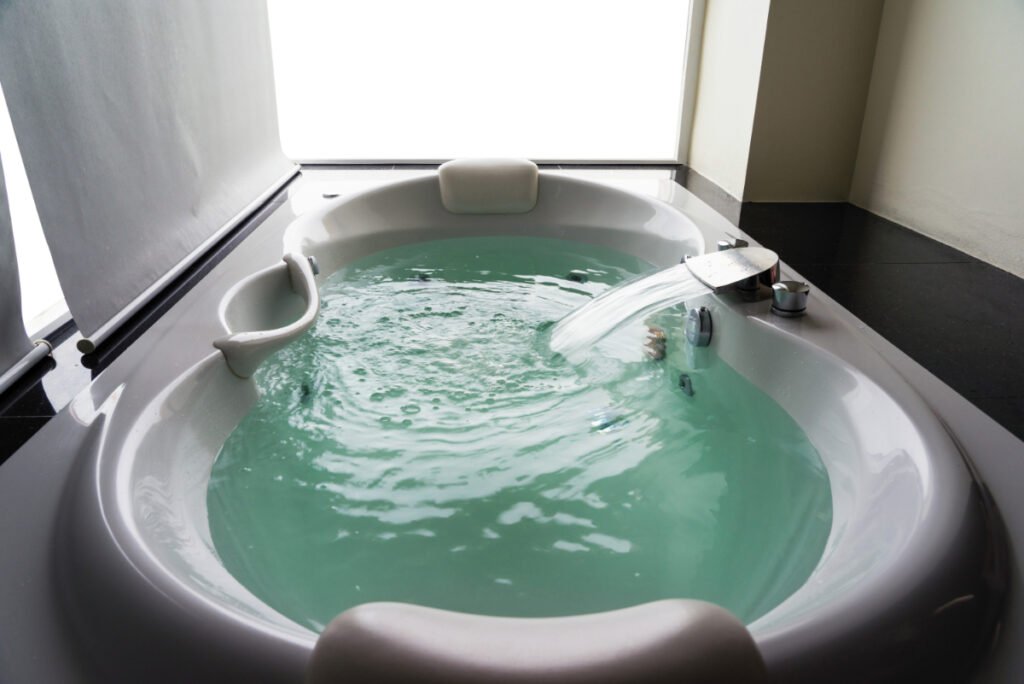
Where to use: Use these for jacuzzi and spa-like experiences in water-scarce regions and compact bathrooms.
Air tubs are very similar to whirlpool tubs but use strong air jets and heating elements that maintain bubbles and warmth for a longer time. Moreover, these have a running pump that prevents bacteria and soap scum buildup and facilitates easy cleaning without much maintenance. Plus, they are self-cleaning, quieter, and exude a shiny, timeless appearance.
Prominent Materials: Acrylic, Poly-Resin, and Fiberglass.
Things to Note:
- They are more cost-effective and cost around $800-1500.
- Are a little heavy and require additional bathtub supports or floor reinforcements.
| Whirlpool Tubs | Jetted Tubs or Air Tubs |
| They have around 5-16 targeted water jets that provide a massage-like experience. | They have about 20-30 air jets that allow proper water circulation within the tub. |
| It doesn’t have a water heater and gets cold faster. | It comes with a heater and maintains optimal water temperature throughout. |
| Uses targeted hydrotherapy and increases water force at pressure points. | Maintains uniform water circulation and temperature throughout the tub. |
| Customizable positioning, direction, and intensity of the water jets. | Has fixed positioning and orientation but allows you to set the intensity. |
5. Walk-in Bathtubs
Where to use: Install these in compact bathrooms and elderly spaces.
Walk-in tubs have a water-resistant door that opens at tile level and creates a tight water seal that retains water when closed. These tubs are handy for sick and older people as you won’t need to bend to get in. However, most of them require at least two walls and a deck for tub support and additional grab bars and chains as backing.
These tubs are a bit expensive: about $4000-6000 per unit, with an additional installation charge of $2500.
Prominent Materials: Fiberglass with gel coat, acrylic or porcelain enamel resin.
Things to Note:
- These tubs take about eight minutes to fill and drain, by which time the person is cold and freezing.
- Walk-in tubs have fewer options for temperature control, and since you enter the tub before filling it, you get no chance to set a favorable temperature.
6. Hot Tub
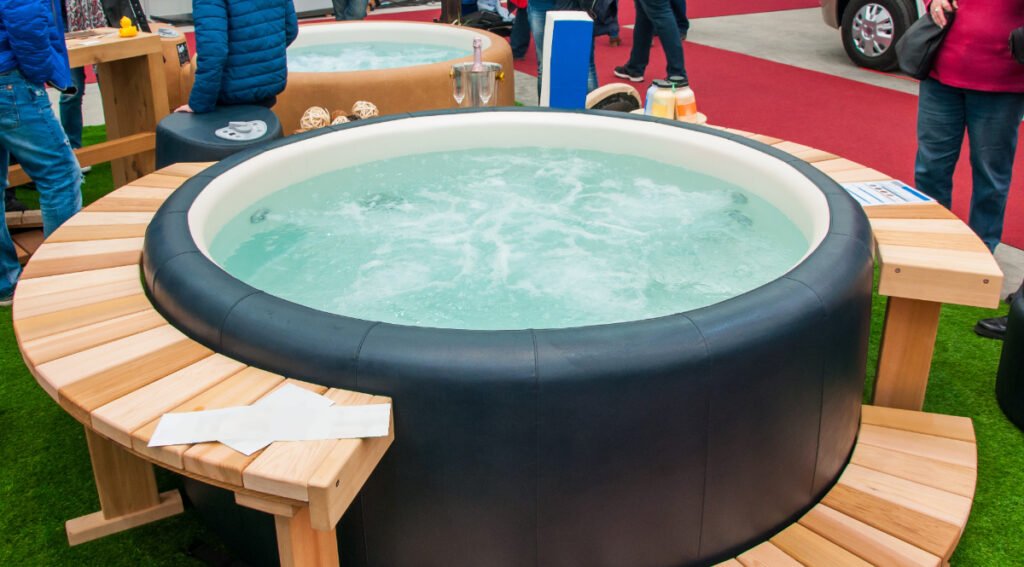
Where to use: Pick them for jacuzzis or a spa-like experience in large baths, cubicles, or even decks.
Hot tubs are large above-ground tubs with a water heater and additional fixtures like jets, bubbles, or in-built seats for hydrotherapy. These typically house more people simultaneously and have their own floor-mount plumbing and electrical systems that maintain the water pressure and temperature within the tub.
Further, these have a double-insulated acrylic coating that prevents heat loss and, thus, is more affordable and energy-efficient than most spas and jacuzzis.
Prominent Materials: Wood, Faux Stone, Brick, and Acrylic.
Things to Note:
- A hot tub is easier to install but has other variable expenses for cleaning, heating, and maintenance that make it expensive.
- It has a less resale value of 25-33% of the original cost.
Bathtub Options Based on Installation
Bathtubs come in various mounting techniques, and while most anchor to the wall, some other tubs can be installed directly from the floor. So, we handpicked some bathtub options for easy installation in any space.
7. Alcove Tub
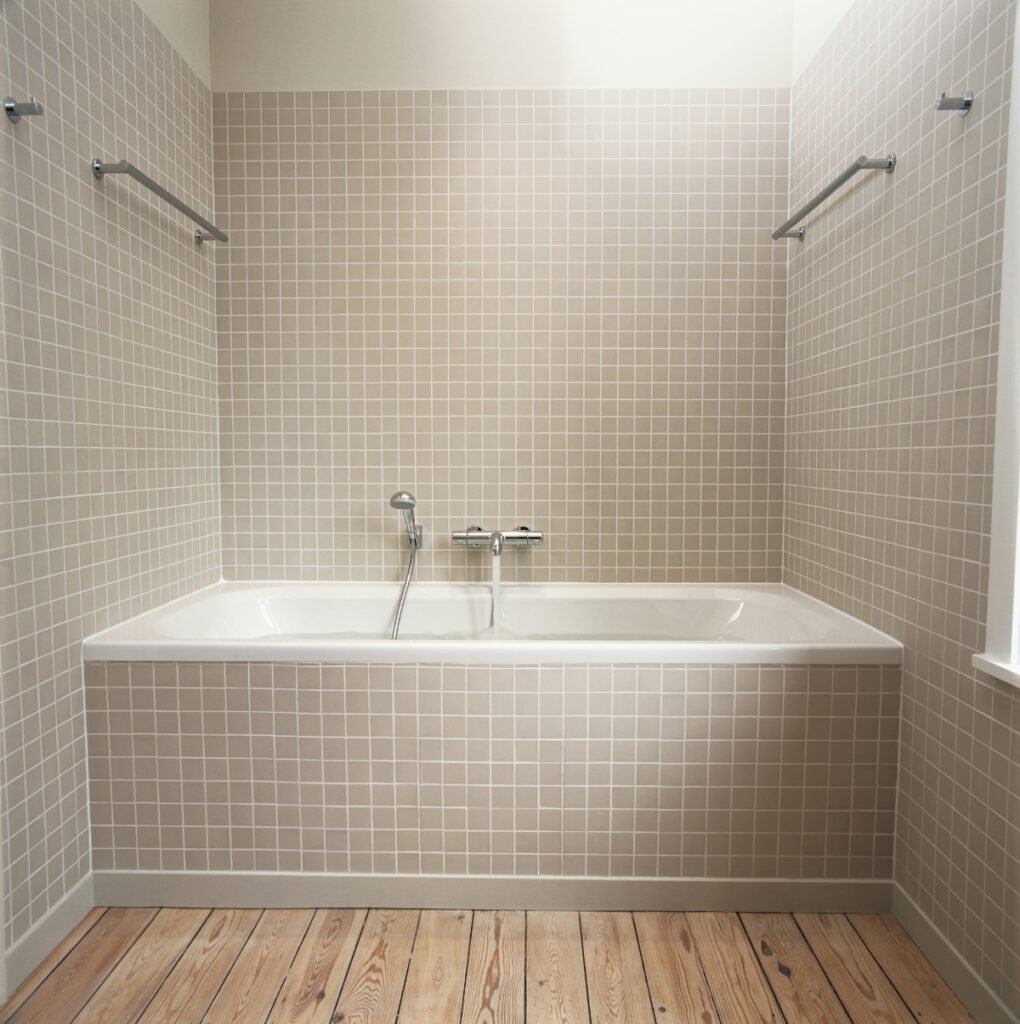
Ideal Location: Compact bathroom or cubicle with a tub-shower combo.
An alcove bathtub has walls on three sides and an access edge on the fourth, making it the most space-efficient option for any bathroom. These are usually rectangular and about 60 – 72 inches long, making them easy to clean and maintain. Further, alcove bathtubs generally prefer wall-mounted faucets, but you can use deck faucets for oversized tubs.
Prominent Materials: Fiberglass, Acrylic, Stone-resin, and Cast Iron.
Key Characteristics:
- An alcove tub is much shallower and narrower than other soaking tubs.
- Cost-efficient and roughly costs $650-700.
- An alcove tub requires a tiled bathtub surround and a good-quality tub liner for more durability.
8. Freestanding Bathtub
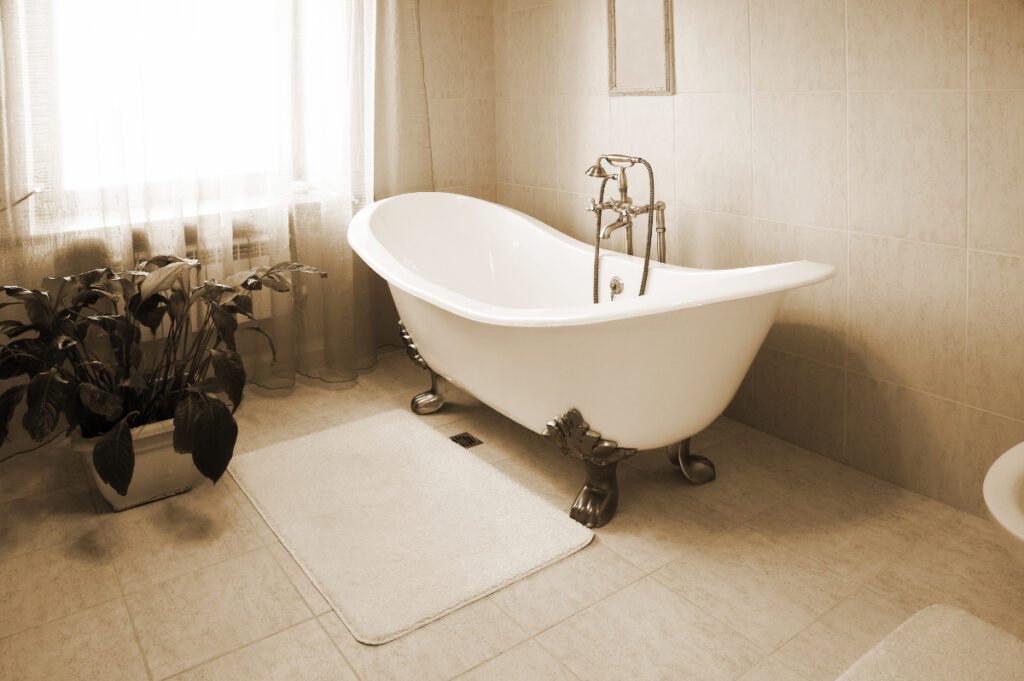
Ideal Location: Bathrooms with many partitions or decks or even luxurious bath cubicles.
Freestanding bathtubs are large, modern tubs with a crisp aesthetic and a floor-mounted plumbing system that allows freedom of location. They come in many materials and finishes and are pretty deep for a good soak. However, they might need additional floor reinforcements and supports since they rest on a feet base and have no wall anchors.
Prominent Materials: Fiberglass, Acrylic, Porcelain, Metal, Woode, Ceramic, and Polymer.
Helpful Tips to Maintain Your Freestanding Bathtubs:
- Freestanding bathtubs are not easily accessible to kids and older people, and you’ll need to install a shower bench to compensate for their depth.
- These are harder to clean. So, it’s advisable to scrub them with a good quality grout brush and bleach them later.
Freestanding Bathtubs are further classified into the following types:
- Single or double-ended tubs: Sloped but rounded or oval tubs with a plumbing trap and drain pipe in the center and a bathtub faucet at either end.
- Slipper tubs: These are single-sloped, shoe-like tubs that allow the user to stretch comfortably with an overflow pipe at the lower end.
- Clawfoot Bathtubs: A clawfoot bathtub is a vintage, freestanding tub that rests on four feet and has high walls for good soaking and relaxation. It is more durable than the other bathtub options, distributes its weight evenly to the floor, and maintains more balance.
- Soup-bowl Tub: Soup bowl tubs are round and elliptical with a center-directed slope and drainage facility. However, they are challenging to get into and might need bathroom chairs or benches for support.
- Freestanding Corner Tubs: These are triangular and comprise a single-sided slope that fits into the corners and cubicles of compact baths.
9. Corner Tub
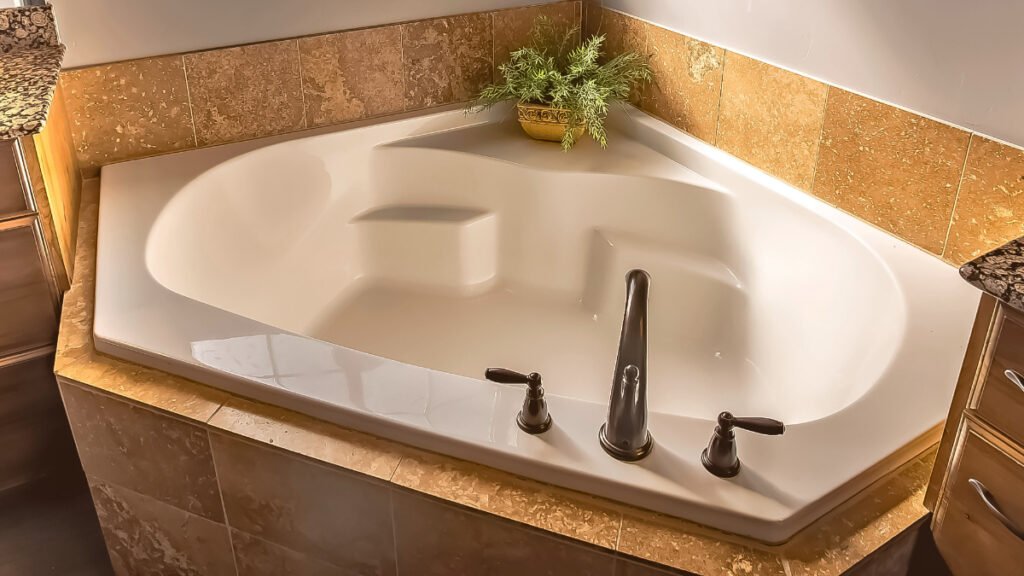
Ideal Location: Odd-shaped corners and niches in luxurious bathrooms.
Corner tubs are triangular and a design-effective option to utilize corners and nooks efficiently. These are single-sloped and often have jets and spa features that facilitate hydrotherapy and soaking. However, they are not space-efficient and take a long time to fill and drain. Plus, they don’t retain heat and might not maintain optimal water temperature.
Prominent Materials: Fiberglass, Acrylic, Porcelain, Stone, and Cast Iron.
Key Characteristics:
- A corner bathtub is expensive and costs about $3000-5000, depending on the material.
- It is more spacious and might not fit into compact bathrooms.
10. Drop-In Bathtub
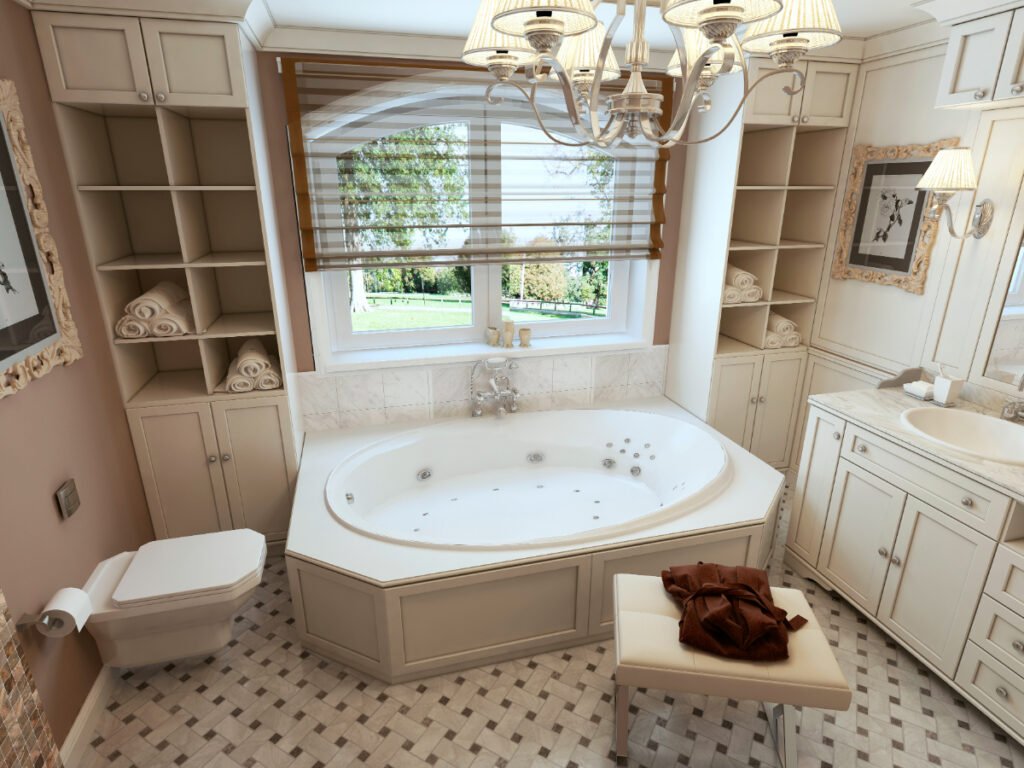
Ideal Location: Compact bathrooms or decks with additional storage.
Drop-in bathtubs are solid, egg-shaped tubs with a solid rim and liner that fit into a preset deck and allow for more storage and shelf space at their edges. These tubs are not only durable and easily accessible but also have a waterproof lining that prevents leaks and heat loss. Plus, they have tiled bathtub surrounds and look more finished and modern.
Prominent Materials: Fiberglass, Acrylic, Stone Resin, and Cast Iron.
Key Characteristics:
- They are highly affordable and cost about $2000 for large-sized tubs.
- They require a customized, on-site deck for installation.
- These tubs are difficult to install on your own and require professional help that might hike the costs.
11. Undermount Tub
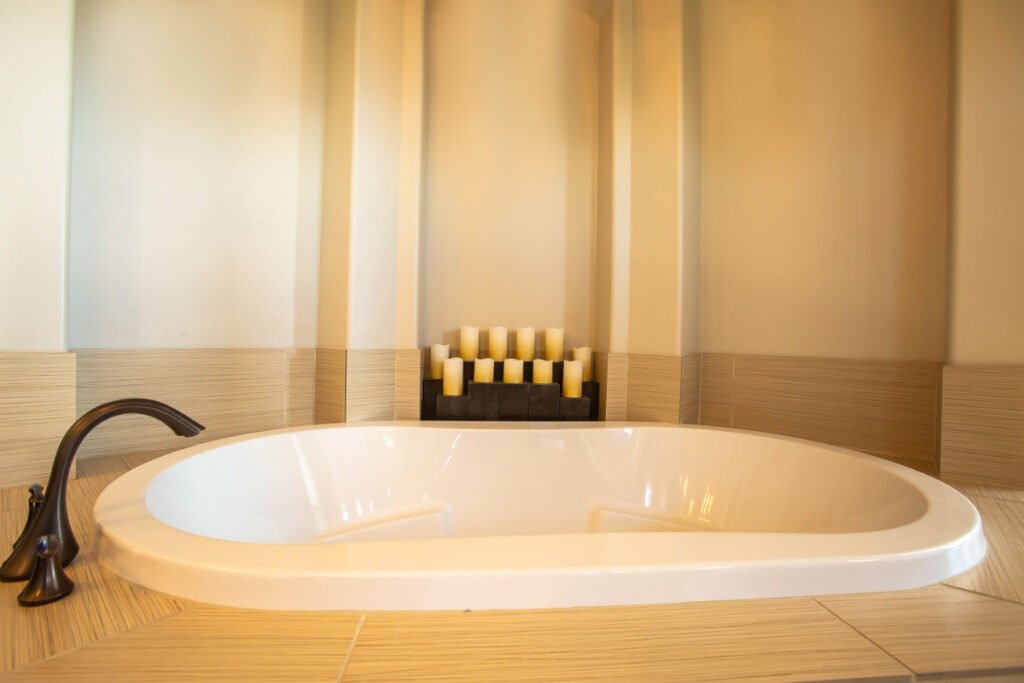
Ideal Location: Luxurious bathrooms with decks and a lot of floor space.
Undermount tubs are similar to drop-in tubs but have a covered rim and a basin with heavy tile or stone surrounds. These are sleek and refined to look at and add a tone of luxury and spaciousness to any bath. Moreover, they have deep tub sides and additional accessories like jets, speakers, and showers, making them ideal for soaking.
However, they are a little challenging to install as the framing is done right up to the upper surface of the tub and needs precision and professionalism to avoid damage.
Prominent Materials: Stone and Tile for the deck with an acrylic bathtub or copper tub ingrained underneath.
Key Characteristics:
- They are incredibly affordable and cost about $1500-2000 for a large-sized tub.
- These tubs have a spa-like aesthetic and are durable and easy to clean.
- You cannot repair or replace them without breaking the surrounding deck.
Types of Bathtubs Based on Decor
No two bathrooms are the same, and there will always be a mix and match of different design styles that shape the space. Fortunately, we have a tub for every decor style – traditional, modern, or transitional- but each has its limitations and setting. So, without further adieu, let’s dig into the list.
12. Japanese Tub
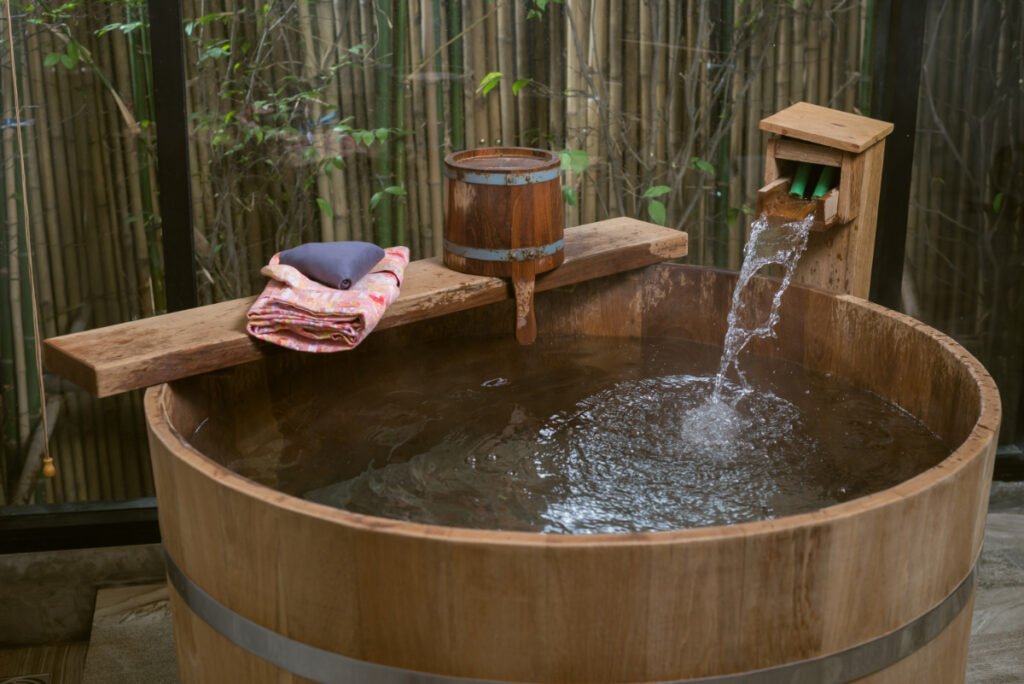
Decor Style: Japanese, Japandi, Scandinavian, and Contemporary.
Japanese tubs are deep, round but freestanding bathtubs with a gently sloped design and a long, 65-70 inch diameter that makes them comfortable for soaking. Further, they have a sharp, modern appeal and an earthy aura with a simple design that enhances the resale value of your home. Plus, these bring calmness to the room and are very space-efficient.
Materials to Pick: Wood, Stone, Porcelain, Ceramic, Acrylic, Fiberglass and Porcelain Enamel Steel.
Cost: About $2000-5000 for a medium-sized tub, depending on the material.
13. Pedestal Tubs
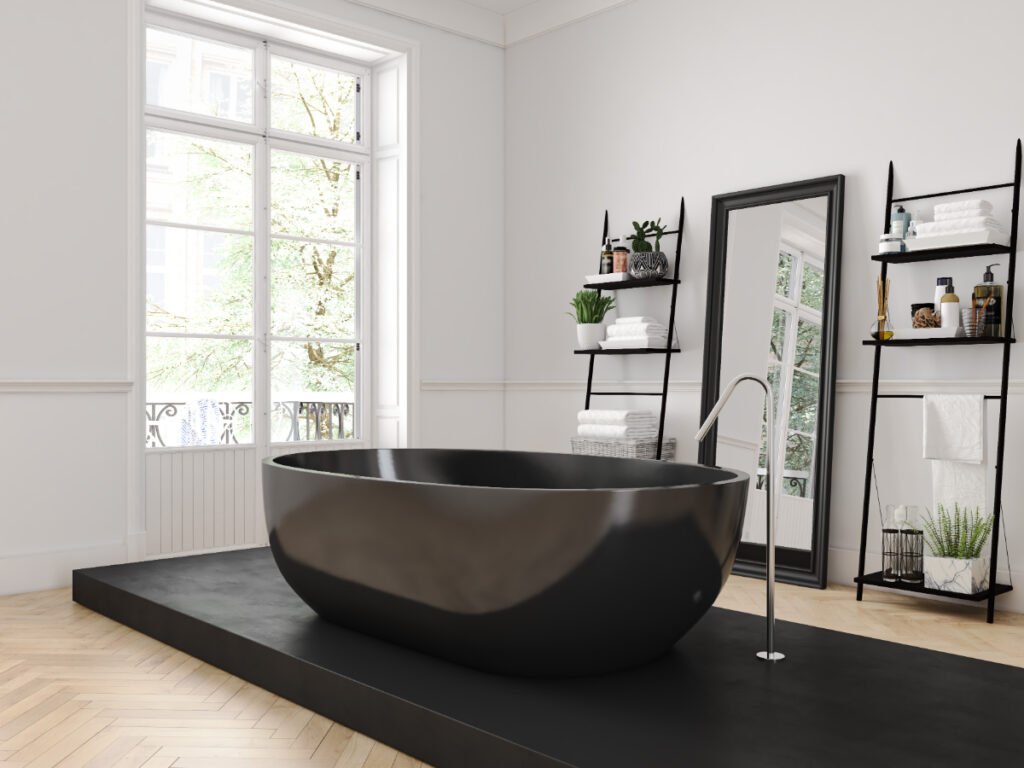
Decor Style: Transitional, Semi-classical, New-classical, and Eclectic.
Pedestal bathtubs are an extension of the traditional clawfoot tub and have a plinth or platform that raises them from the floor. These are freestanding and luxurious, about 70-75 inches long, but have a classic appeal and a double-ended, rectangular appearance.
Moreover, these tubs are minimal and have clean, sleek lines with a textured finish.
Materials to Pick: Acrylic, Polymer, Fiberglass, and Cast Iron.
Cost: About $1000-3000, depending on the material and finish.
14. Contemporary Bathtubs
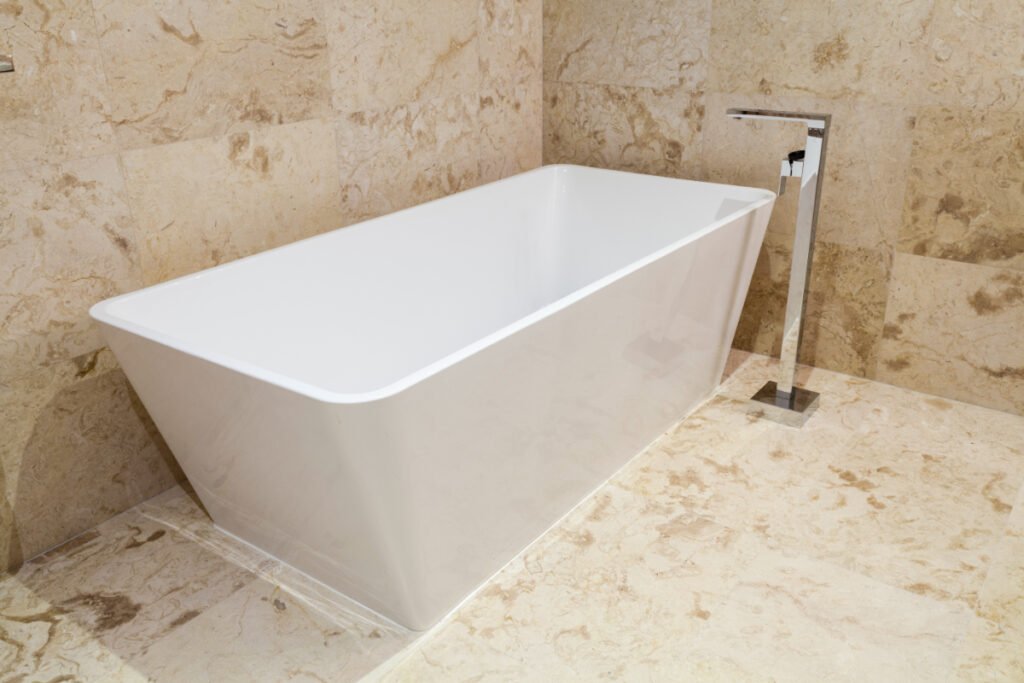
Decor Style: Modern, Minimal, Zen, Fusion, and Eclectic.
Contemporary bathtubs are freestanding but have a single-sloped design with an access point at the lower edge and a faucet at the top. These are curved and slightly fluid with varying thickness that looks sturdy and soft simultaneously. Further, these look spacious, futuristic, and clean and exude a high-end aura within your bathroom.
Materials to Pick: Acrylic, Synthetic Resin, Fiberglass, and Porcelain.
Cost: About $2000-3000 for a medium-sized tub.
15. French Bateau Bathtub
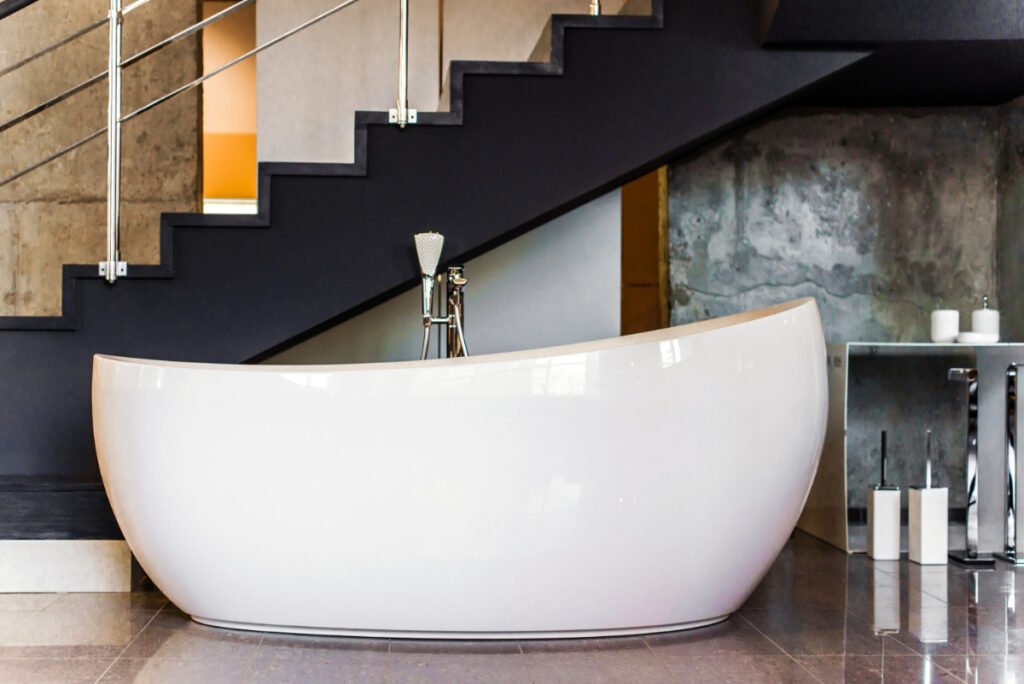
Decor Style: French country-style, Neo-classical, and Traditional.
Bateau tubs are simple, flat, and boat-shaped and have high sides and edges that hold more water and retain heat for a longer time. They have low, double-ended slopes, a bucket appearance, exposed external plumbing, and a plinth that raises the tub from the floor.
Further, these have roll-type sidings and a symmetrical tub interior that oozes traditional attire in luxurious master bathrooms and bath decks.
Materials to Pick: Durable, metallic materials like cast iron, zinc, and steel.
Cost: About $3000-4000 depending on the material.
Types of Bathtubs Based on the Materials
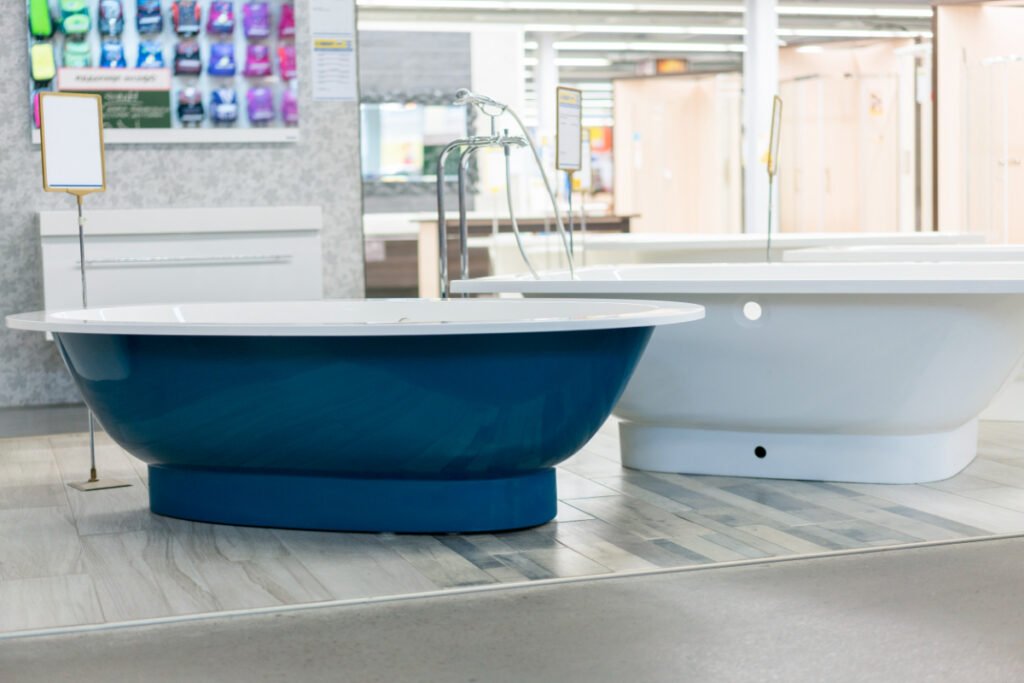
Bathtub materials impact any bathtub’s overall durability, wear, tear, weight, and longevity. Thus, choosing a suitable bathtub material will not only reduce the overall maintenance cost of the tub but also help you upgrade your bathroom on a budget. But what are these materials? Let us find out.
16. Fiberglass Tub
A fiberglass bathtub is thinner, shinier, flexible, and affordable but might chip, crack, or discolor with time.
17. Acrylic Tub
Acrylic bathtubs are durable, cheaper, and non-porous but do not resist heat effectively and might warp.
18. Steel Tubs
Steel tubs are heavier and more expensive but are more durable and stain-free.
19. Cast Polymer Tubs
Polymer tubs like resin or cultured marble are stain-free and durable but might chip and scratch easily.
20. Porcelain Tub
Porcelain tubs are inexpensive, stain-free, and chemical-resistant tubs with a protective coating and a shiny finish.
21. Copper Bathtubs
Copper bathtubs are mildew-resistant,anti-bacterial, and long-lasting but can rust and turn green if not appropriately maintained.
22. Stone-Resin Tubs
These blend crushed stone and resin and look organic and polished but are expensive and heavy.
23. Cast Iron Tub
Cast iron tubs are long-lasting, maintenance-free, and dent-free but are heavy and require a professional installation.
24. Enamel Tubs
These are shiny, modern, and lightweight but might weather with continuous use and cause leakage.
25. Composite Bathtubs
Composite tubs are a mixture of two or more bathtub materials and are lightweight, durable, and maintenance-free. However, they are more expensive and are not favored for low-rise baths.
26. Wood Tubs
Wood tubs come in various shapes and sizes and look natural and luxurious. Plus, they prevent heat loss and hold warm water for longer.
27. Solid Surface Bathtub
Solid surface tubs are transparent, shiny, and elegant but are vulnerable to molds and might turn white with heavy cleaning.
Bathtub materials are indeed the most critical factor for any bathtub. You can learn more about the pros, cons, and specifications of different bathtub materials here.
Things to Consider When Buying a New Bathtub
Bathtubs come in an array of materials, textures, and finishes, and while each might not match your style of bathroom decor, we have picked some tips and tricks to help you find the best fit for your bathroom.
- Size of the Tub: Standard bathtubs are typically 60 inches long and 32 inches wide and might not fit well in compact or decked bathrooms. Thus, you’ll need to measure your bathroom thoroughly and pick alcoves, freestanding, or garden tubs accordingly.
- The Shape of the Tub: Bathtub shapes influence the comfort and design of the bathroom to a greater extent. Generally, oval or elliptical tubs are more user-friendly and modern, while rectangular tubs are suitable for stretching but look more traditional.
- Analyze your Bathroom Walls: Analyze the location of your bathroom walls and choose a suitable wall to anchor the tub and drill the vents. You can always pick a freestanding tub if you have closely spaced walls and partitions.
- Bathtub Materials: Consider the material of the bathtub and check if your flooring materials and shower tiles can withstand their extra weight. Generally, porcelain enamel or fiberglass bathtubs are much lighter and portable, while metal or cast iron tubs are heavy and corrosive.
- Bathtub Finishes: For industrial decor, choose high-gloss bathtub finishes against shiny shower tiles, or go with matte or semi-gloss finishes for a rustic ambiance with rough-textured walls.
- Durability: Durability is an essential aspect of long-running, repair-free tubs, and while an iron tub is solid and hot water-resistant, materials like porcelain or acrylic are much brittle and can chip, deteriorate or weather easily.
- Cost: Cost is a crucial factor for any cost-saving bathroom remodeling. However, wooden bathtubs are expensive and might soar to about $30,000. In contrast, enamel or acrylic tubs are much cheaper and cost about $1500-2000.
Do bathtubs have a standard size or Dimensions?
Bathtubs do not have a standard size, but most branded bathtubs are 60 inches long, 30 inches wide, and about 15 inches deep. However, larger soaking tubs might be about 72 inches long and 30 inches deep, but they will have a seat installed on one of the edges.
What is the difference between a bathtub and a soaking Tub?
Bathtubs are generally broader and less deep, whereas soaking tubs are less expensive but have a minimum depth of 23 inches. Moreover, soaking tubs are not used for bathing and do not have other accessories like showers or grab bars.
Which is the cheapest bathtub available in the market?
Plastic or enamel alcove tubs are highly cost-effective and cost about $650 per unit. However, these are not long-lasting and might turn yellow and degrade with age. Hence, it’s advisable to go with fiberglass or acrylic ones that are moderately priced but are more efficient in the long run.
Bathtubs are the crux of a good bathing experience and impact decor and user comfort. The choice of your tub depends on personal priority, comfort, and bathroom size. Our categorized list will help you pick the best bathtub and upgrade your bathroom instantly!
Don’t forget to check out the article on the types of bathtub drain stoppers to choose the one that best fits your bath.

